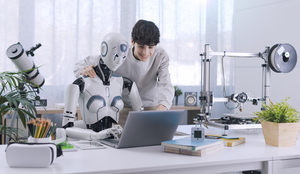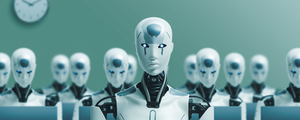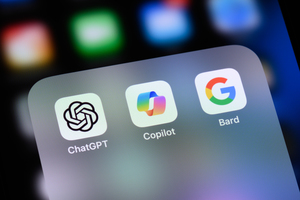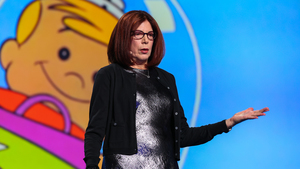
 |
Charlotte Stonestreet
Managing Editor |
| Home> | IIot & Smart Technology | >Big Data | >The human + AI equation |
| Home> | IIot & Smart Technology | >Connectivity | >The human + AI equation |
| Home> | IIot & Smart Technology | >IIoT | >The human + AI equation |
Editor's Pick
The human + AI equation
27 January 2025
At Automation Fair, futurist Anat Baron explored how to foster a culture of innovation that maximises the strengths of both human expertise and artificial intelligence. Charlotte Stonestreet was there

ACCORDING TO Anan Baron’s LinkedIn profile she ”knows what’s coming next and what you should do about it”, so she was certainly an inspired choice to present one of the keynote presentations at Rockwell’s most recent Automation Fair.
Baron, who is not just a futurist but a highly successful entrepreneur and strategic advisor, started by contextualising our current moment as part of the Fourth Industrial Revolution, where the convergence of technologies such as the internet, mobile, and the cloud has laid the groundwork for unprecedented advancements - advancements which are not always viewed in the most positive light: “For the longest time, Hollywood has shown us a vision of the future, and it is pretty dystopian. But I'm here to tell you that we, all of us collectively, are creating the future. So if we want it to be dystopian, it will be. We still have agency in what happens,” she asserted.
To illustrate the scope of technological transformation, Baron drew parallels between predictions made in pop culture and today’s reality. Referencing The Jetsons—the 1962 animated series that envisioned a futuristic world 100 years ahead—she noted how many of its speculative technologies have become real: "Tablets, the Apple Watch, the Internet, Alexa, drones, telehealth, holograms, Roomba, and even treadmills for dogs." Unlike the dystopian visions often portrayed in modern media, Baron highlighted how The Jetsons presented technology as a force for good, a guiding philosophy she urges businesses to adopt.
“What's so interesting about The Jetsons was that there was a time in America where, in Hollywood, these writers sat around and thought about the future, 100 years ahead, so 2062, and they thought about technology as a force for good. They thought about creating objects and things that would make our lives better."
Merging of physical and digital lives
Drawing the audience back to the present day, Baron explored how technology has dissolved the traditional boundaries between work and personal life. She described this phenomenon as "life flow"," where "we no longer have a dividing line between our work life and our life, personal life. It’s just all one thing".
She looked at how the rise of digital nomadism, remote work, and hybrid teams has redefined the workplace. This shift demands transparency and authenticity from both individuals and organisations. "Those who embrace transparency and authenticity are going to win," Baron predicted.
Hyper-personalisation, she added, is another hallmark of this era. "Consumers want to be in the middle," she explained. "It’s no longer about the company."
The ability to cater to individual needs – whether through on-demand services or AI-driven recommendations – has fundamentally reshaped consumer expectations.
"We have an insatiable appetite to get what we want, the way we want it," she observed, emphasising the need for businesses to adapt to these evolving demands.
AI myth busting
In the realm of AI, Baron tackled prevalent myths head-on. "AI is not a recent development," she clarified, pointing out that its roots go back to the 1950s. She also addresses the misconception that AI thinks like humans: "It feels like you’re talking to a person. That’s the Turing test, right? But the reality is, it doesn’t think." Instead, AI operates as a powerful tool that augments human capabilities rather than mimicking human consciousness.
One of the most pervasive fears surrounding AI is job displacement. Baron confronted this concern with nuance: "AI will replace some jobs. If your job can be done by a robot, your job will be done by a robot." However, she tempered this with hope, urging individuals to focus on critical thinking and creative problem-solving. "It’s not going to replace all jobs, but it will replace some. Mostly, it’s going to be about reskilling."
Baron also debunked the fear-mongering narrative that AI will become a malevolent force: "Hollywood keeps scaring us with this idea that AI is going to kill us all. I don’t think that’s happening." Instead, she sees AI as a collaborative partner, one that businesses must learn to integrate thoughtfully.
"We are still the boss of AI," she asserted, emphasising human agency in shaping its use.
Game changing generative AI
Generative AI, exemplified by tools like ChatGPT, represents a significant leap forward in how businesses and individuals interact with technology. Baron referred to the rapid adoption of ChatGPT, which reached 100 million users faster than any previous technology. "There’s hunger out there for new technology, for finding new ways to interact with it," she noted. While adoption is still in its early stages, the potential applications of generative AI are vast, spanning industries from healthcare to education to logistics.
Baron highlighted the rise of AI agents and agentic applications as the next frontier. These tools go beyond generating content or answering questions – they can take actions on behalf of users. "They can write code, book travel, and perform tasks," she explained. This capability is set to revolutionise workflows, enabling businesses to automate routine tasks and free up human workers for more strategic endeavours.
The implications extend to areas as mundane as household chores. Baron cited the example of Digit, a robot capable of sorting laundry using human language. "How amazing would that be for those of you who do laundry or clear the dishwasher?” she mused, painting a picture of a future where technology handles repetitive tasks, giving people more time to focus on what matters.
Human-AI collaboration
Central to Baron’s vision is the concept of human-AI collaboration. She described a "human in the loop" model, where AI operates as a partner rather than a replacement. Drawing on the example of commercial aviation – where autopilot systems work alongside human pilots—she outlined the principles of effective collaboration: "Clear role definition, a safety layer, and priority of the human." This approach ensures that humans retain control while leveraging AI’s capabilities to enhance efficiency and decision-making.
Baron also emphasised the role of cobots (collaborative robots) in augmenting human labour. Unlike traditional robots that operate in isolation, cobots work alongside humans, dynamically adapting to their environment. "They do all the dull and repetitive work," she explained, freeing up human operators to focus on more complex tasks. This symbiotic relationship exemplifies how technology can enhance human productivity without diminishing human agency.
Tsunami of Change
Acknowledging the overwhelming pace of change, Baron likened the current moment to a tsunami: "It’s all coming at us really quickly." For businesses, this underscores the urgency of adopting AI thoughtfully and responsibly. "Think about AI that augments us as opposed to something that replaces us," she advised, advocating for a culture of experimentation and adaptability.
She also stressed the importance of responsible AI practices, including transparency, ethical considerations, and regulatory frameworks. "Hopefully there will be some guardrails and regulations," she said, though she acknowledged that this remains a work in progress.
Baron concluded her session on an optimistic note, urging the audience to embrace the opportunities presented by AI while staying grounded in human values. "We have the ability, we have the experience, and we have the wisdom," she asserted. By leveraging AI’s capabilities alongside human traits like critical thinking, creativity, and empathy, businesses can achieve transformative outcomes.
She offered a compelling vision of collaboration: "If the outcome you want is increased efficiency and productivity, we use human adaptability and the speed and scale of AI." Similarly, for faster problem-solving, she highlighted the synergy between human critical thinking and AI-driven data analysis.
In closing, Baron reiterated that the future is not something that happens to us – it is something we create. "AI is here to stay, and it’s up to all of us to integrate it into our lives in such a way that it makes us flourish." Her message is clear: the Fourth Industrial Revolution is not just about technology; it’s about how we, as humans, choose to shape and navigate this brave new world.
You can catch up with more of the Automation Fair keynotes on demand at:
www.rockwellautomation.com/en-gb/events/automation-fair-on-demand.html
- MIDRANGE CONTROL
- Scalable analytics for IIoT
- Taking on the challenge
- Rockwell and Microsoft deliver shared vision to accelerate industrial transformation
- Rockwell acquires Clearpath Robotics
- Rockwell launches new open architecture industrial computers & thin clients
- How the Danish navy put new wind in its sails
- Device support expanded
- Help to achieve best-in-class safety performance
- Leading EDGE seminars address key business issues
- Balls to Gravity
- ROBOTS GIVE FASTER CELL TOOL CHANGE TIMES
- ROBOT FOR DELICATE ASSEMBLY
- NUMBER OF ROBOTS IN UK ON THE RISE
- The future is bright - The future is automation!
- High Demand For Grant
- More Capacity, Less Space
- FREEBIRD - THE THIRD DIMENSION
- PRECISION ROBOT CELL FOR THE PHARMACEUTICAL INDUSTRY
- ROBOT SALES REACH ALL TIME HIGH






















